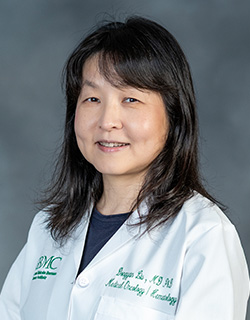Cause for Celebration: One Woman's Triumph over Breast Cancer
December 3, 2013
Jeannine Moriconi, mother of three and married to her high school sweetheart, had her annual mammogram in 2012, but the journey that followed was anything but routine. Her rigorous course of treatment for breast cancer was concluded with a celebration of life and love. This is her story, in her own words.
I wasn’t completely surprised when I received a call following my annual mammogram in April 2012 requesting that I come back for additional films. I’d had questionable results on previous mammograms that required biopsies, though they all had been benign. I didn’t become anxious until the radiologist explained that the films showed calcifications, which can indicate cancerous cells, and said he wanted to take multiple biopsies. Having lost three friends to breast cancer, including my best friend just a year prior, I had a bad feeling as I nervously awaited the results.
General surgeon Frank Rotolo, MD, told me that the biopsies showed I had ductal carcinoma in situ (DCIS), a noninvasive form of breast cancer. He explained that DCIS is considered Stage 0 breast cancer and is highly treatable without chemotherapy. Lumpectomy and radiation are commonly used to treat DCIS, but given my history of abnormal mammograms, I opted for a mastectomy. I wanted to decrease the chance of the cancer spreading or coming back. I had a bilateral mastectomy and reconstruction in August 2012, and I was feeling good about my decision and my future.

One week after the surgery, my husband Jim took me to my post-operative appointment, which went much differently than expected. Dr. Rotolo sat down and looked at us with a pained expression. “I don’t know how to tell you this, but it’s worse than we thought,” he said. I was shocked to learn that additional testing on the tissue that they removed indicated I had a more invasive Stage 2-A cancer, which had traveled to my lymph nodes. I thought that by electing to have the mastectomy I was going to be fine, but it turned out that was only the beginning.
Armed with the knowledge of my new diagnosis, I met with oncologist Robert Donegan, MD, who outlined a treatment plan of chemotherapy and radiation. The new diagnosis was frightening, but I felt comforted by all the doctors and nurses at GBMC. Having my complete care team under the same roof was both convenient and reassuring. When I was hospitalized for five days with an intestinal reaction and colitis following my first chemotherapy treatment, nurses were by my side through it all, and I could tell they truly cared about me. After Dr. Donegan changed my medication to prevent those complications, I had four chemotherapy sessions — once every three weeks — followed by 12 consecutive weekly treatments. The positive support around me kept me going. I took the drug Herceptin every three weeks for a year and concluded with six weeks of radiation under radiation oncologist Albert Blumberg, MD. Through the course of my treatment, I never felt alone when I was at GBMC.

The support of my family and friends through this journey has been incredible. On my last day of treatment, October 10, 2013, my husband orchestrated a surprise for me at GBMC. I had planned to do the ritual bell-ringing outside the Sandra & Malcolm Berman Cancer Institute to signify I had completed my last treatment, but I wasn’t expecting a massive celebration! When I walked outside, I saw the faces of more than 100 friends and family crowded into the vestibule to celebrate with me. There were yellow balloons everywhere — the color of celebration — and every row had people from all different parts of my life. There was my entire family, my childhood friends, our friends from Rhode Island, my son’s rugby coach and of course GBMC staff. I looked at Dr. Donegan and said, “This is why I have been able to get through all of this.” The physical and emotional recovery process has been a challenge, but I am focusing on enjoying life and the people around me. I’m fortunate to be where I am, and thankful to have had such outstanding care.








